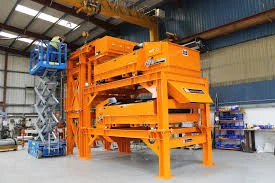

ное. . 25, 2024 04:33 Back to list
Eddy Current Aluminum Separation A Breakthrough in Recycling Technology
In recent years, the push for sustainable practices has driven innovation across various industries, particularly in waste management and recycling. One area witnessing significant advancements is the separation of non-ferrous metals from waste streams, among which aluminum stands out as a highly recyclable material. The implementation of eddy current separation technology has revolutionized the way aluminum is recovered from mixed materials, showcasing an efficient and effective approach to maximizing recycling efforts.
Understanding Eddy Current Separation
Eddy current separation is a physical process that utilizes electromagnetic fields to separate conductive materials, such as aluminum, from non-conductive or different conductive materials. The principle behind this technology stems from the phenomenon of eddy currents, which are loops of electric current that are induced in conductive materials when exposed to a changing magnetic field.
In an eddy current separator, a magnetic rotor spins at high speeds, creating a rapidly alternating magnetic field. When a mixed material stream containing aluminum passes through this field, eddy currents are induced in the aluminum particles only. This results in a repulsive force that propels the aluminum away from other materials on a conveyor belt, effectively separating it.
The Benefits of Eddy Current Separation for Aluminum Recovery
1. High Efficiency One of the standout features of eddy current separation is its ability to achieve high separation rates for aluminum. Unlike manual sorting or other mechanical methods that may struggle with complex mixtures, this technology can rapidly process large volumes of material, ensuring that aluminum is efficiently recovered and minimizing contamination with other materials.

2. Cost-Effectiveness Although the initial investment in eddy current separation equipment may be significant, the long-term savings it offers are substantial. By increasing the recovery rate of aluminum, recyclers can significantly reduce costs associated with disposal and landfill fees. Moreover, aluminum is a valuable commodity in the recycling market, making its recovery financially advantageous.
3. Environmental Impact Aluminum recycling has a smaller environmental footprint compared to primary aluminum production. Using eddy current separation not only helps in conserving energy but also reduces the demand for mining new bauxite ore, thereby lessening the environmental degradation associated with mining activities. The recycling process typically consumes 95% less energy than producing aluminum from raw materials, further underscoring the importance of efficient separation techniques.
4. Versatility Eddy current separators are versatile devices that can be used in various applications beyond just aluminum recovery. They can process various materials, enabling recyclers to extract multiple metals from a single stream, enhancing the overall efficiency of recycling operations.
Challenges and Considerations
Despite its advantages, there are challenges associated with eddy current separation. The technology may require careful calibration and maintenance to ensure optimal performance. Also, highly contaminated aluminum streams may require pre-sorting processes to enhance the separation efficiency. Moreover, while eddy current separators excel at separating aluminum, they may not distinguish between different types of non-ferrous metals, necessitating further processing.
Conclusion
Eddy current aluminum separation represents a significant advancement in recycling technology, playing a crucial role in the responsible management of metal waste. As the world strives toward more sustainable practices, technologies like eddy current separation not only enhance recovery rates but also contribute to a circular economy by ensuring that valuable materials like aluminum are reused rather than discarded. Embracing such innovations is essential for fostering a more sustainable future, one that prioritizes both economic viability and environmental stewardship. As more recycling facilities adopt this technology, the opportunities for efficient resource recovery will continue to expand, further highlighting the importance of aluminum recycling in a resource-constrained world.
Latest news
Eddy Separator for Non-Ferrous Metals
NewsAug.22,2025
E Waste Bin for Collected Spray Cans: Sustainable Disposal Solutions
NewsAug.22,2025
Dual Shaft Shredder with Adjustable Blade Gaps
NewsAug.22,2025
Hammer Crusher Machine With Secondary Crushing
NewsAug.22,2025
Copper Granulator Our Promise of Recycling Excellence
NewsAug.22,2025
Industrial Shredders Crafted for E-Waste Recycling
NewsAug.22,2025